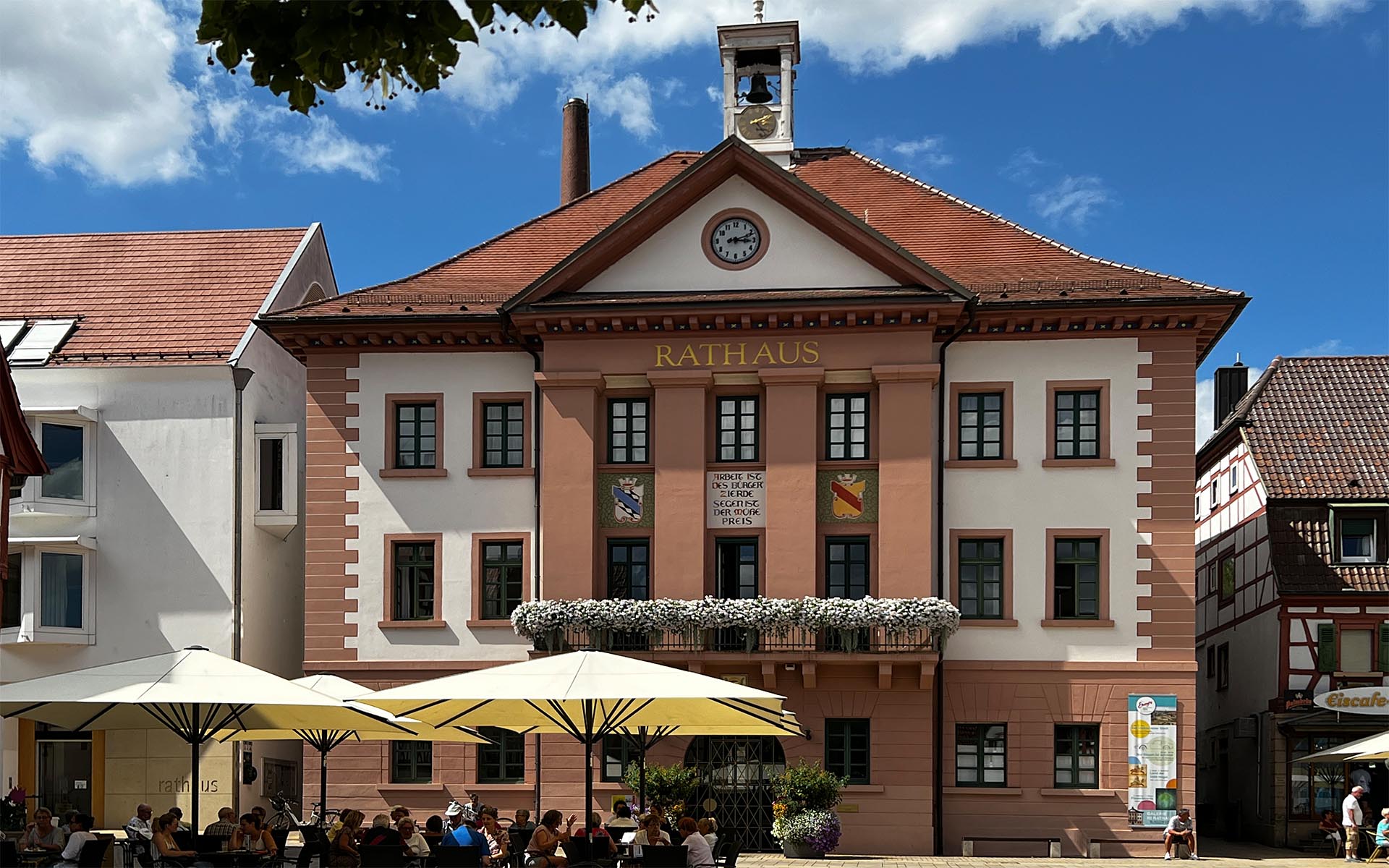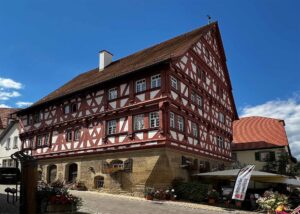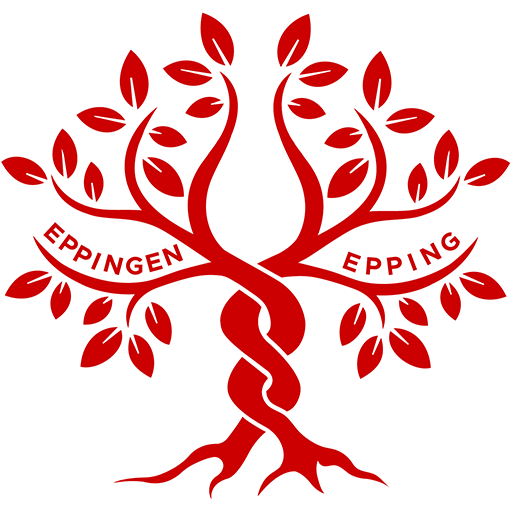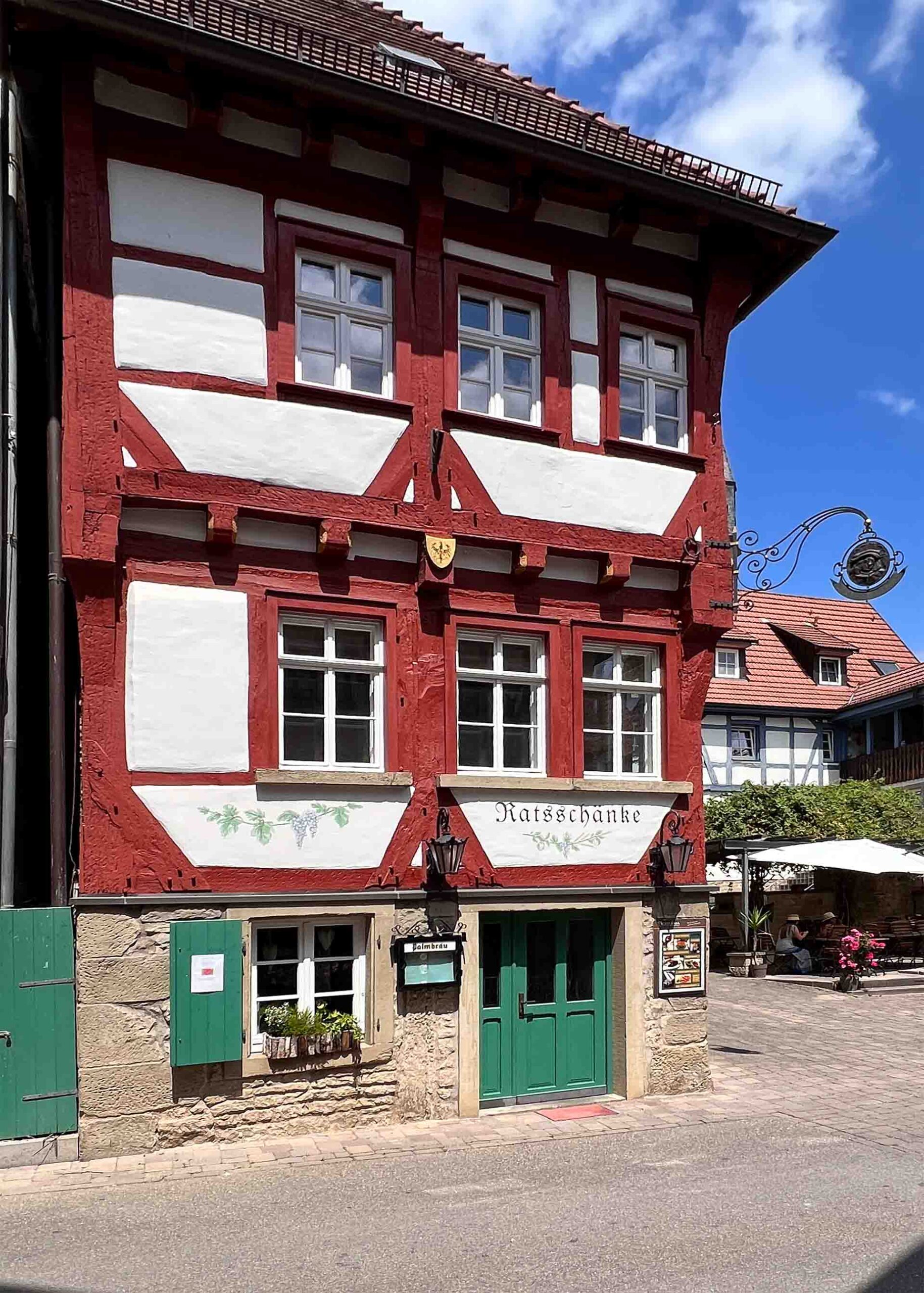Eppingen in the Kraichgau

Eppingen Town Hall
The town of Eppingen is in the south-west German state of Baden-Württemberg, and is situated in the hilly area known as the Kraichgau. It lies within an approximate circle formed by the cities of Heidelberg, Heilbronn, Stuttgart, Pforzheim and Karlsruhe
The ‘half-timbered town’
The area around Eppingen, with its fertile loess soil, was first settled over 6,000 years ago. We then see traces of Celtic and Roman occupation – the area was part of the Roman Empire for several centuries.
It is believed that a village stood on the site of the present town in the fifth century CE, but the first written record dates from 985.
Like many other villages, Eppingen was awarded civic status during the Middle Ages, around 1190.
The town in its prime
Eppingen’s heyday was in the early modern period. It has survived the ravages of history relatively unscathed, and is now among the most beautiful towns in the Kraichgau region. Eppingen flourished particularly after 1463 when it was incorporated into the Palatine Electorate lands, then a significant part of the Holy Roman Empire. Then, after the Reformation, the Electorate became one of the most active Protestant powers. Eppingen profited from being authorised to hold markets, and also derived income from forestry rights and customs duties. The citizens valued education highly, and in 1421 they founded a grammar school which facilitated social advancement through further study at Heidelberg and other universities. In 1564 part of Heidelberg University even relocated to the relative safety of Eppingen for several months, when Heidelberg was afflicted by plague.

Eppingen around 1645 in Matthäus Merian’s Topographia Palatinatus Rheni
Magnificent half-timbered houses
The town’s wealth is epitomised by its particularly large and beautiful half-timbered houses – the entire Old Town is now a conservation area. These houses remain largely intact in spite of the devastation of the Thirty Years’ War (1618–1648), which did not spare Eppingen and decimated the inhabitants of surrounding villages. Then during the Nine Years’ War (1688–1697) the French laid waste to much of the surrounding area, including Heidelberg Castle. However, Eppingen also escaped this lightly – not least because of the ‘Eppingen Line’, a series of ramparts, ditches, palisades and watchtowers, hastily constructed by citizens and soldiers between 1695 and 1697. These defences also helped keep nearby Heilbronn safe from the French armies.
Into the present
In 1803, under Napoleon, Eppingen became part of the Grand Duchy of Baden, and in 1813 was granted administrative rights over a wide area. This gave the town a new economic impetus and the population increased. The mediaeval town walls, which restricted expansion, were demolished. Modern farming techniques were introduced in the surrounding area. By 1823 Eppingen had acquired a new town hall and administrative buildings. New churches and a synagogue also appeared. In 1879, the railway arrived.
After World War I, however, Eppingen lost its status as a seat of local government. Then, under the National Socialist regime, the Jewish population was deported and murdered. The town now commemorates these former Jewish citizens by means of ‘Stolpersteine’ – memorial plaques set in the pavement. The town was not spared by World War II, and the railway station in particular was subjected to air raids.
An attractive place to live and to work
Today Eppingen is again a seat of local government, situated in the administrative county of Heilbronn. It has a population of around 22,000 across the town itself and the six outlying communities of Adelshofen, Elsenz, Kleingartach, Mühlbach, Richen and Rohrbach. There are many commercial enterprises and a range of schools and colleges. Leisure interests are well catered for by a wealth of cultural and sporting associations.
Heidelberg, Karlsruhe, Heilbronn and Mannheim are within easy reach by rail, and there are good links to the A5 and A6 motorways. Stuttgart and Frankfurt are a little further away.
Eppingen is twinned with Epping (UK), Wassy (France) and Szigetvár (Hungary).
In 1958 the town was awarded a coat of arms. The colours black, red and gold predominate: the left half has a diagonal bar in red on a gold background, symbolising Eppingen and the region of Baden; the right half has a gold imperial eagle on a black background.
More places to see
Pfeifferturm (Hornblower’s Tower)
This tower lies on the former boundary of the Old Town, and is its oldest surviving structure. It was built in the 13th century as a watchtower to guard against foe and fire. The tower keeper lived in a half-timbered structure at the top (which no longer survives), and if danger threatened he would blow a horn. His other duty was to wind up the tower clock (since relocated to Eppingen town hall).
The main gateway into the town was formerly next to the tower, which is over 30 metres high and about 2 metres wide at the base. Today, 112 steps lead to a viewing platform 24 metres above ground level, which gives the visitor a spectacular view. https://de.wikipedia.org/wiki/Pfeifferturm (in German, with photo) https://de.wikipedia.org/wiki/Pfeifferturm
Alte Universität (Old University)
This is the largest half-timbered building in the Old Town. It was constructed at the end of the 15th century as a meat market, but it also incorporated a meeting room, a grain store and a wine cellar. It was here that local farmers brought their tithes in the form of foodstuffs for storage. It was here that, in 1564, part of Heidelberg University relocated when that city was beset by plague – hence the building’s current name. Later it became a school for children from the Jewish community. Today, the building houses a permanent exhibition of ‘half-timbering’, where visitors can learn about this construction technique and about the history of Eppingen.
Catholic Church of Our Dear Lady
This church stands at the highest point of the Old Town. The nave was built around 1435, but the tower is earlier – in the chapel there can be seen magnificent Gothic wall paintings dating from about 1320. The top section illustrates Jesus’s childhood, then come scenes from his suffering and death, and below that the twelve Apostles are depicted.
In 1971, the church was extended and modernised. It is home to one of the largest glockenspiels in Germany, which sounds 49 bells every hour throughout the day.
Baumannsches Haus (Baumann’s House)
 This half-timbered building dates from 1583 and its gables are 18 metres above ground level. One of the most outstanding examples of domestic architecture in the region, it is named after one of its original owners. As well as its interesting structure, it has a lot of carved ornamentation including mythical creatures, rosettes, St Andrew’s crosses and human forms. https://de.wikipedia.org/wiki/Baumannsches_Haus_(Eppingen)
This half-timbered building dates from 1583 and its gables are 18 metres above ground level. One of the most outstanding examples of domestic architecture in the region, it is named after one of its original owners. As well as its interesting structure, it has a lot of carved ornamentation including mythical creatures, rosettes, St Andrew’s crosses and human forms. https://de.wikipedia.org/wiki/Baumannsches_Haus_(Eppingen)
Ratsschänke (Municipal Hostelry)
This corner house is one of Eppingen’s oldest, having been built in 1483. The building is believed to have started life as an infirmary. Its massive cellar is of particular note. https://de.wikipedia.org/wiki/Ratsschänke_(Eppingen) (In German, with photo)
Modellhöfe (‘New-design houses’)
Margrave Frederick VII of Baden-Durlach (1647–1709) commissioned the rebuilding of farmsteads, homes and businesses that had been destroyed during the Nine Years’ War. He promoted modern architectural principles, with particular emphasis on fire prevention. Eppingen boasts many of these ‘Modellhöfe’, constructed somewhat later, mainly in the first half of the 19th century. The living quarters front onto the street, with workshops and storage in a courtyard at the rear. The courtyard was accessible to laden wagons by virtue of a wide, high, gated archway. Stout walls separate each terraced property from its neighbours. https://de.wikipedia.org/wiki/Modellhäuser_in_Eppingen (in German, with photos) See also Brettener Straße etc. on Google Streetview.
Raußmühle (Rauss Mill)
This half-timbered water-mill complex, first mentioned in 1334, boasts a European Heritage award. It still has many of its original features (apart from the water wheel and millrace), together with barns and stables. Even the original paving in the courtyard survives. At different times the mill was used for grinding corn, crushing gypsum and processing hemp fibres. Today, the mill houses a large private collection of artefacts to do with rural superstition and magic, together with many types of locks and mousetraps. www.raussmuehle.de (in German, with photos) www.raussmuehle.de

Main building of the Rauss Mill
Ottilienberg (St Odile’s Hill)
This Iron Age hill fort just south-east of Eppingen is over 2,400 years old, and is said subsequently to have been the site of a Roman temple. In the 15th century there was a pilgrims’ chapel here dedicated to St Odile, which was partly destroyed in the Thirty Years’ War. In the 17th century, the hilltop became part of the ‘Eppingen Line’ fortifications, offering protection from French military incursion. Two bombing raids during World War II caused further damage to the historic buildings here. They have since been rebuilt in a different style, but remains of the original chapel can still be seen.
Steinhauermuseum (Museum of Stonemasonry), Mühlbach
Stonemasonry was important in the local area at various periods, as we can see from the museum dedicated to this trade in the historic town hall at Mühlbach, a few kilometres south of Eppingen.
There are many exhibits showing the masons’ intricate workmanship, as well as the hardships they suffered including accidents and dust -related disease.
Bauernmuseum (Museum of Rural Life), Richen
The history of Eppingen and district is above all an agricultural one, as this museum in Richen (just north-east of Eppingen) demonstrates. Visitors are taken inside a typical farmhouse kitchen, living room and bedroom, together with other rooms devoted to rural trades.
Viticulture Museum, Kleingartach
The area around Eppingen, and especially nearby Kleingartach, is famous for its wine. (However, Eppingen itself, with its Palmbräu brewery, is more noted for its beer.) This museum has exhibits explaining the history of wine production locally. Kleingartach also has a ‘biblical wine trail’ and an outdoor exhibition of basket weaving.





